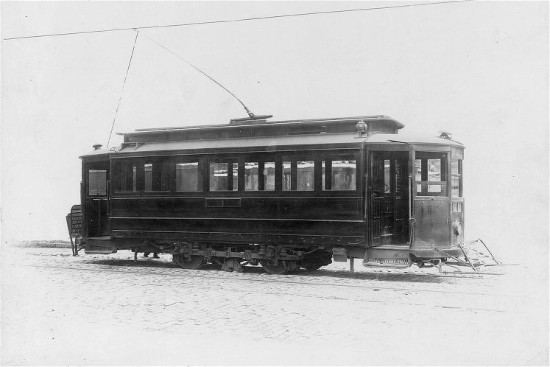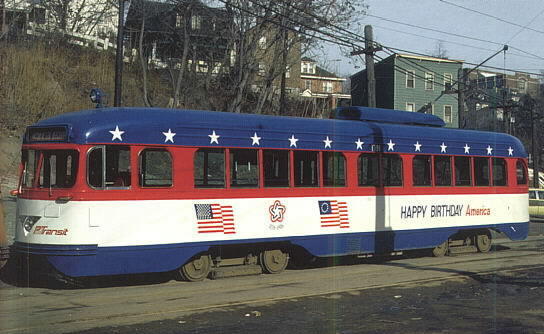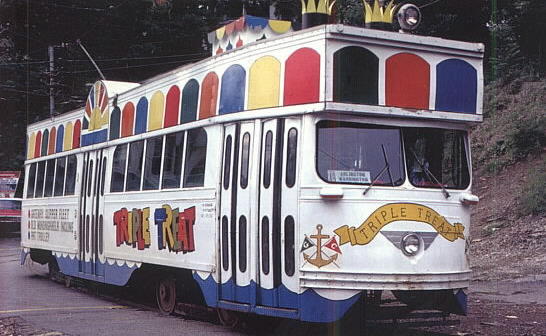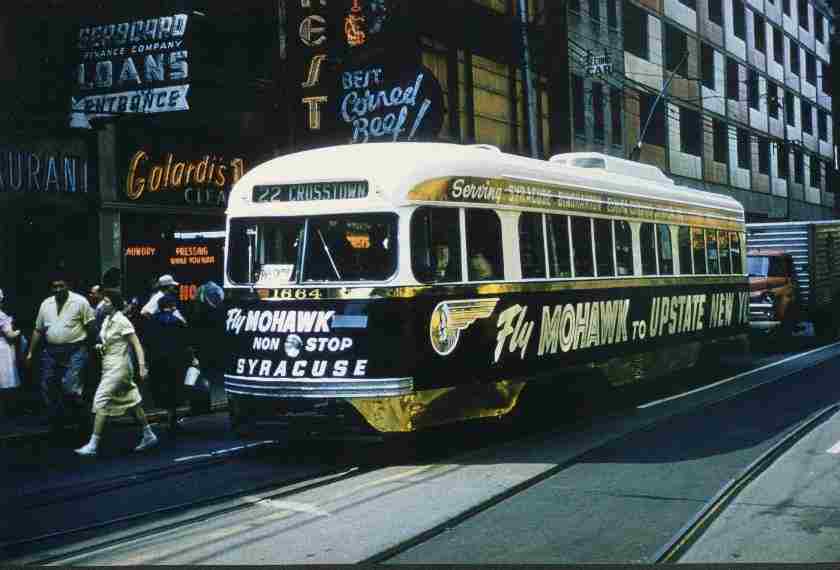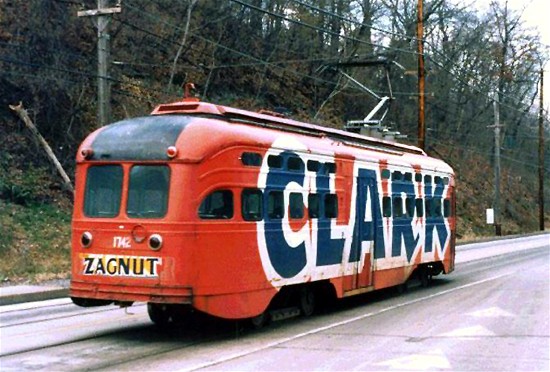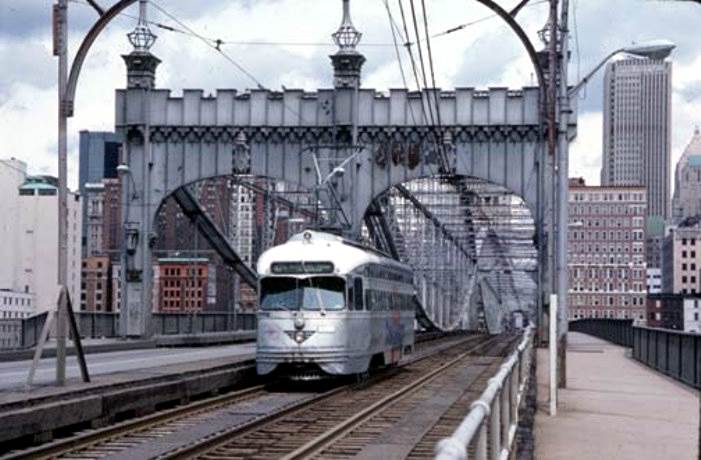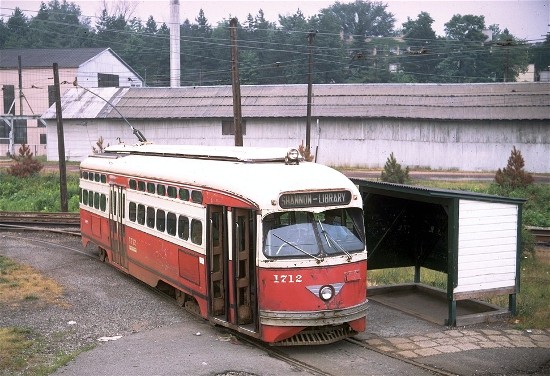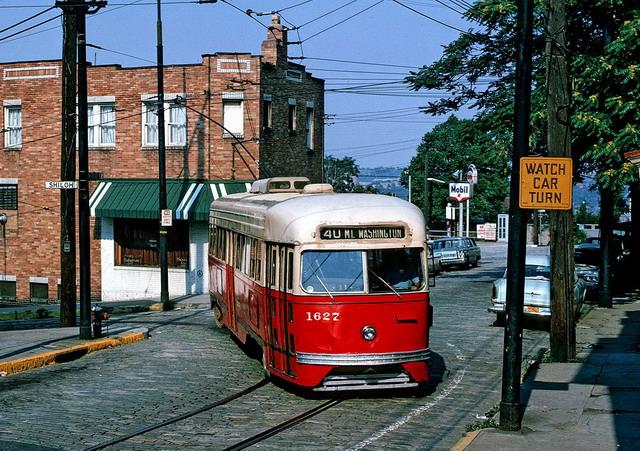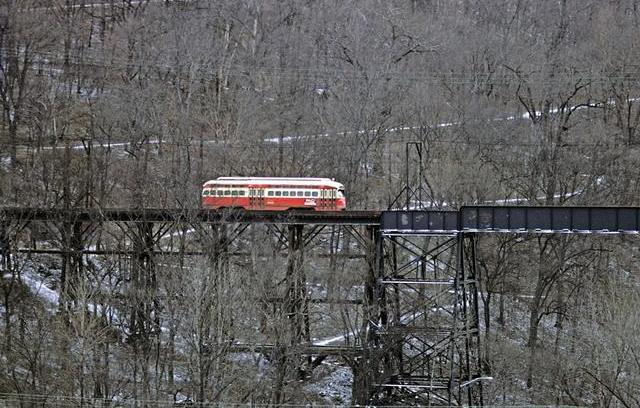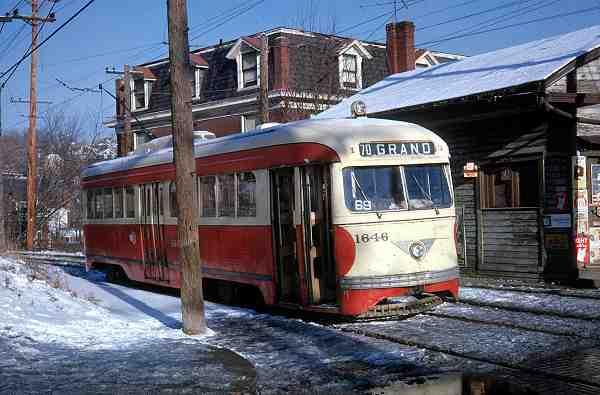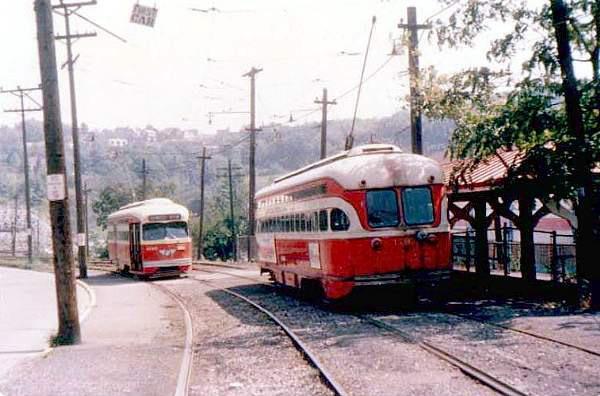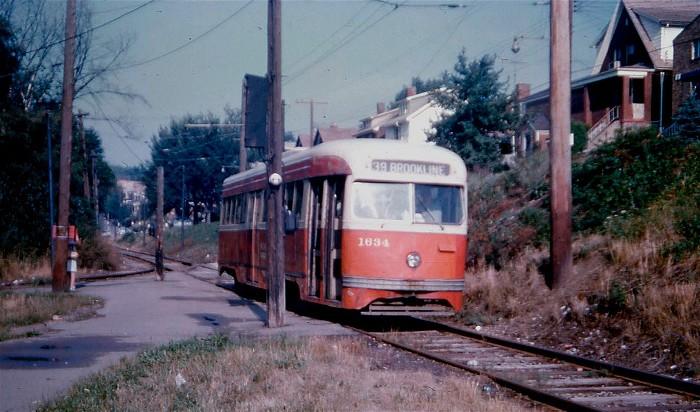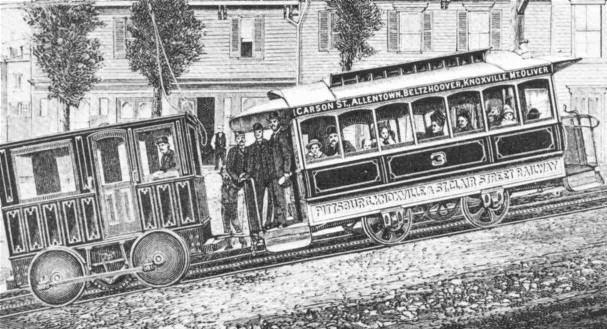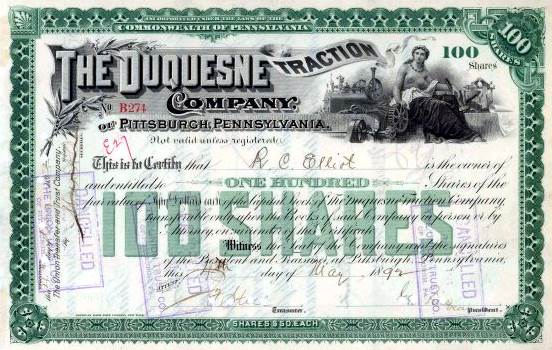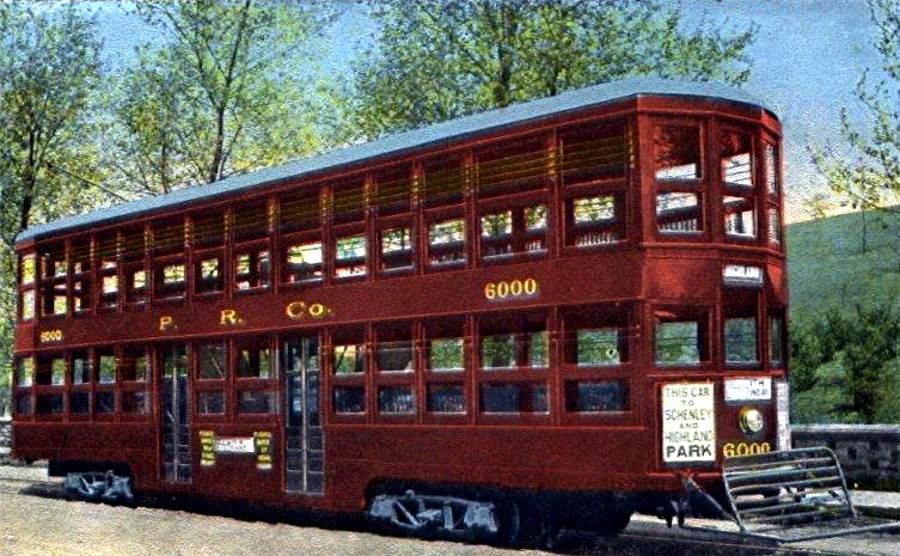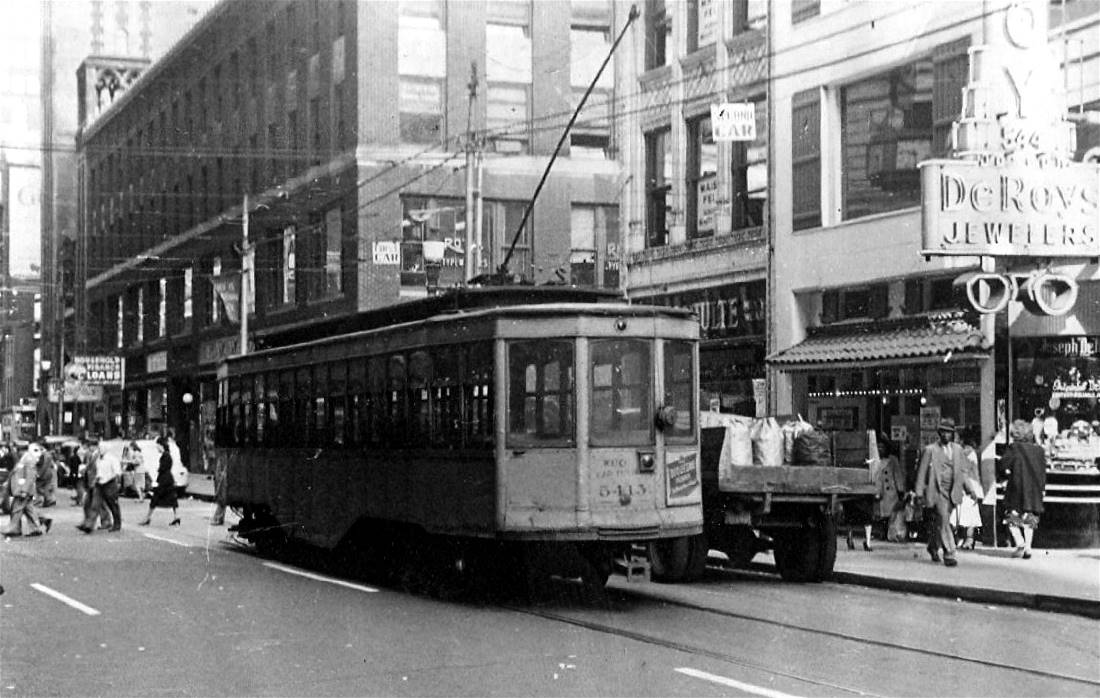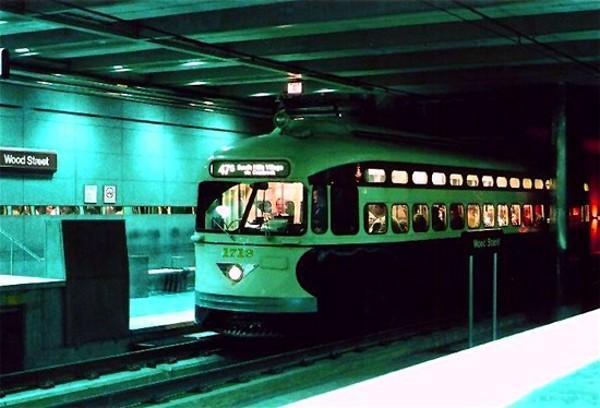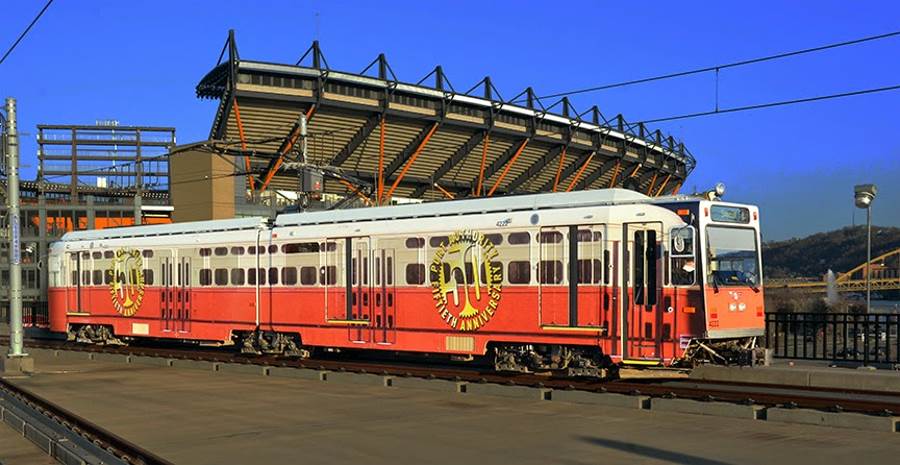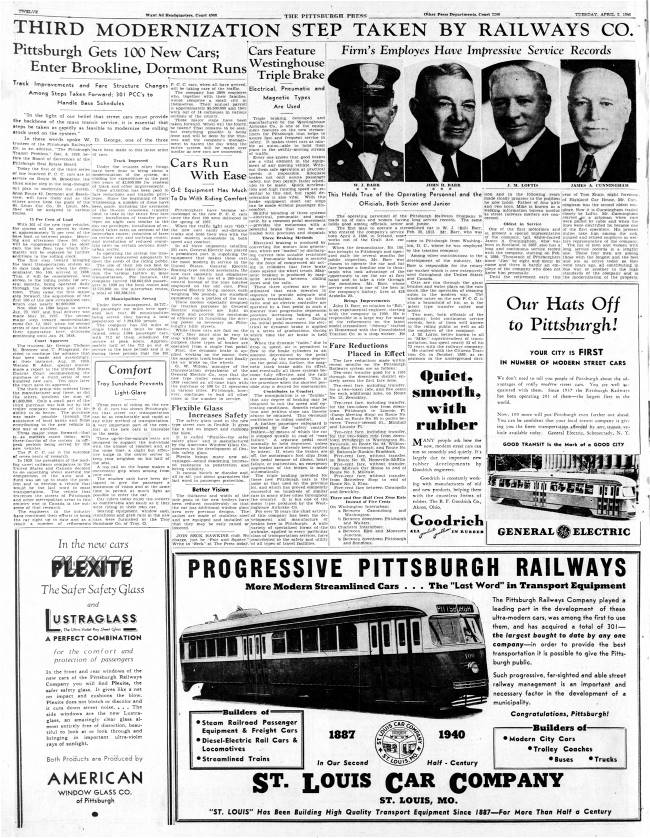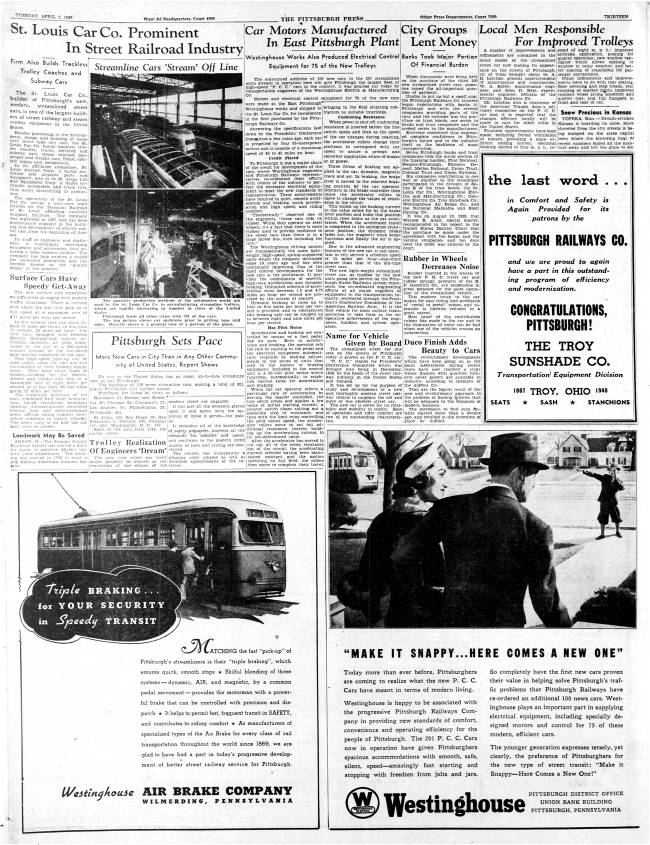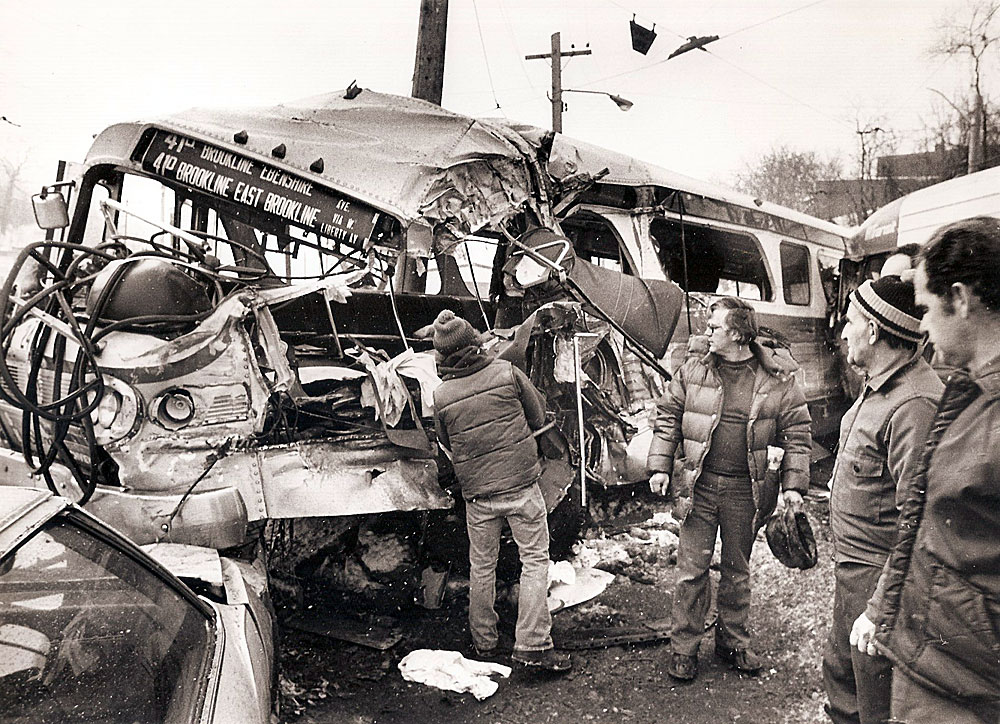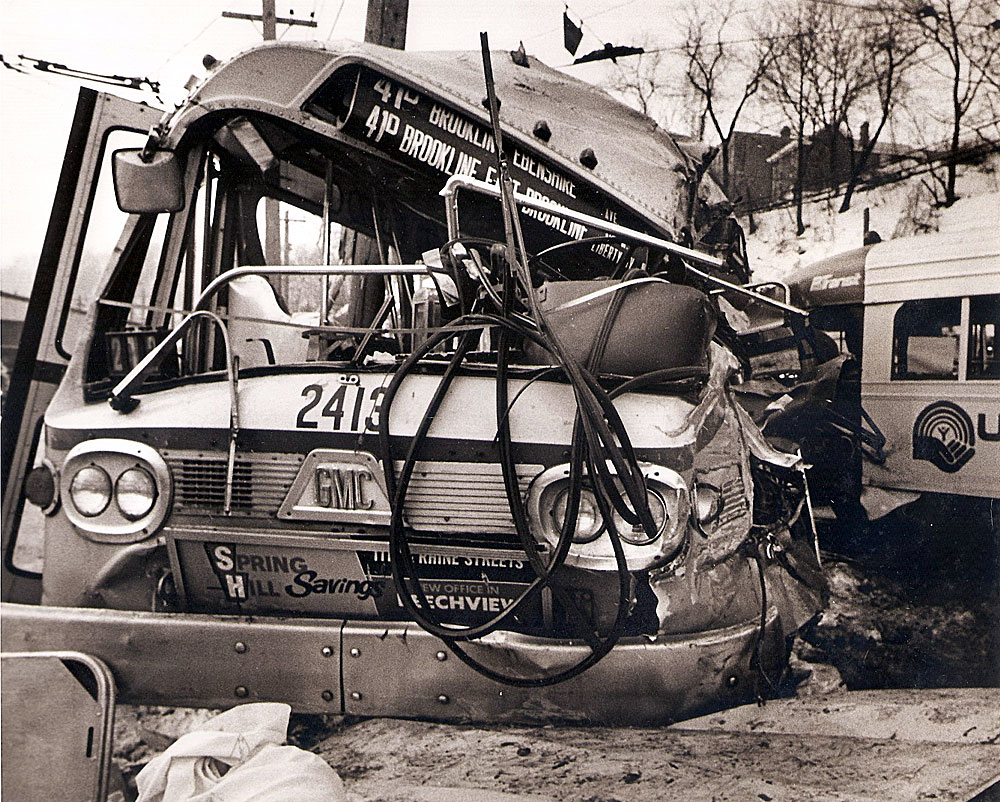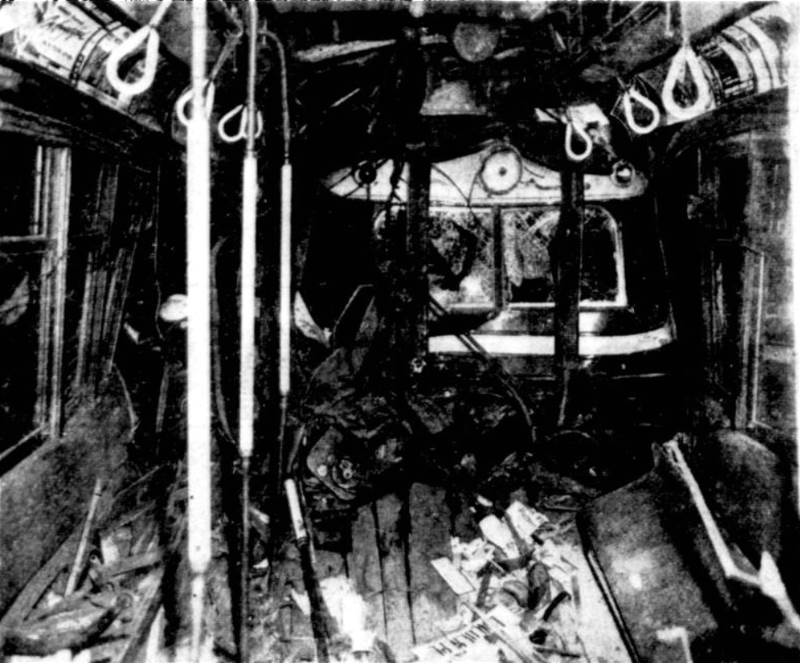|
Trolleys were the main form of transportation in Pittsburgh for over 100 years. The tracks of the West End Traction Company, Southern Traction Company, Monongahela Railways Company, Pittsburgh Railways Company and finally the Port Authority of Allegheny County, ran just about everywhere throughout the city and to the suburbs beyond. In 1918, the peak of the rail era in Pittsburgh, there were 606 miles of single-track. Now only a handful of routes remain on the "T" light rail system, running to the southern neighborhoods, through downtown, and along the north shore. The rail network is still a convenient way to get around the Golden Trianglen area, although the tracks are no longer visible above ground. They now beneath lie beneath the surface in the subway system, established in the mid-1980s. For those who remember the street level tracks running through town, who can ever forget the site of the "Terrible Trolley", the Gateway Clipper Triple Treat, the Bicentenial "Spirit of America," the Mod Desire Psychedelic trolley or the one that looked like a Clark Bar on wheels.
Our Feature Article: ♦ The Pittsburgh & Castle Shannon Railroad (1871-1912) ♦ ♦ Pittsburgh Light Rail Transportation
History ♦ American Motor Coach Association
of Pittsburgh ♦ The Formation of PAT (1956-1964) ♦ Transit Companies That Made Up Pittsburgh Railways
♦ Pittsburgh Railways Company Books ♦ ♦ List of the 280 Companies That Made Up Pittsburgh Railways ♦ Photos Of Trolleys In And Around Pittsburgh Are They Called Streetcars Or Trolleys? There is some debate over whether the proper term for the vehicles that ran the rails on Pittsburgh streets were called "Streetcars" or "Trolleys." The answer is ... both! The official answer might sound a bit strange: A TRAM (also known as a tramcar; a streetcar or street car; and a trolley, trolleycar, or trolley car) is a rail vehicle which runs on tracks along public urban streets (called street running), and also sometimes on separate rights of way. Trams powered by electricity, which were the most common type historically, were once called electric street railways. Trams also included horsecar railways which were widely used in urban areas before electrification. For a more detailed history of trams, visit Wikipedia (Trams).
A Short History On Trolley Service In The City Of Pittsburgh Pittsburgh's trolley history dates to the 1850s when the State Legislature passed a law allowing "motor power companies" to operate passenger railways by cable, electrical or other means. The first passenger service was a horse-drawn trolley that operated in East Liberty in 1859. Since then, the city has been at the forefront of trolley transportation.
JUNE 1887: Pittsburgh Traction Company constructs a cable line beginning at the foot of Fifth Avenue and running east along Shady, Penn and Highland Avenues, a distance of 5.5 miles. The line opens for passengers on September 12, 1889. Various cable lines operate in the City of Pittsburgh until 1897. THE LATE 1890's: The first electric line is constructed from South 13th and Carson streets to Knoxville Borough. That is followed by development of successful and consistent electric trolley service on the North Side and the South Side. In the ensuing years, competing lines are built by 190 trolley operators in the city. The wooden trolley cars have four wheels.
"It was really a hodgepodge," says Scott Becker, executive director of the Pennsylvania Trolley Museum in Washington, near the Meadowlands. JUNE 1901: Pennsylvania's Focht-Emery Transit Bills are signed into law, opening a rush of investors wishing to form new transit companies throughout the region to compete with the established passenger railways. The sweeping domain and financial powers granted under the new legislation fuel the expansion and modernization of Pittsburgh's public transportation system. The bills also led to rampant stock fraud. JANUARY 1, 1902: Pittsburgh Railways Company, a subsidiary of the Philadelphia Company, is formed on June 8, 1901 as a result of the transit bills to consolidate the increasing number of transit companies in Allegheny County. There are 1100 trolleys in operation along 400 miles of single track. Yearly ridership totals 178.7 million passengers with revenue of $6.7 million. The first generation electrified traction cars were wooden cars covered in steel-sheeting, sometimes referred to as "box cars." They were built by the St. Louis Car Company at a cost of $6000 each and introduced in Pittsburgh during the winter of 1902. The eight-wheelers were forty-seven feet long and powered by four fifty-horse power motors. The cars had high floors, narrow doors and sat forty-four passengers on wooden seats. They could be driven from either side of the vehicle by moving directional controls and electrical guide wire from one end to the other. DECEMBER 1, 1904: The Mount Washington Transit Tunnel a 3,500 foot bore through Mount Washington, opens to traffic. The tunnel, from the South Hills Junction to Carson Street, was built at a cost of $875,000. The inner walls were lined with 12,000,000 bricks. This tunnel, along with the Corliss Tunnel (1914) on the West End, led to real estate booms in both the South Hills and Sheridan areas, respectively. A Philadelphia Company executive called it "one of the greatest works ever undertaken in the street railway business. The project will be the making of the South Hills." He was correct. In a span of just one year, three farms in Brookline increased in valuation from $68,000 to $1.3 million. The standard turn-of-the-century streetcar has eight wheels, high steps and narrow doors. This makes traveling slow and cumbersome, particularly for women whose clothes don't allow them to negotiate the cars.
OCTOBER 1906: Company records indicate that there are over 280 subsidiary companies either owned or leased by Pittsburgh Railways. 1912: Pittsburgh's trolley network is growing fast and the number of passengers increasing. Because of the over-crowded conditions during peak times, P.N. Jones, head of Pittsburgh Railways, leads the effort to produce a standard car. The city tries out double-decker cars. About a dozen were built between 1912 and 1924, but they never really catch on in Pittsburgh. 1915: Pittsburgh Railways decides that the new, low-floor Jones Car, built in McKees Rocks, with its sloping floor is going to be its standard car. The company purchases 1000 of them between 1915 and 1927. The steel cars run on 600 volts of direct current and feature rattan seats, beautiful woodwork, windows that open and shaded light bulbs. The cars are well-received by the public. The trolleys are painted orange but their color fades to yellow, prompting most people to call them yellow trolleys. They are used in Pittsburgh until the mid-1950s, when many trolleys are phased out in favor of buses.
In the ensuing years, Pittsburgh Railways experimented readily with a variety of cars, testing aluminum, fiddling with control systems and trying a number of options with wheels. 1918 - The Pittsburgh Railways Company files for bankruptcy. Negotiations with the City of Pittsburgh drag on for six years. Valued at $62.5 million, the companies credit obligations are settled and a city Board of Advisors appointed to oversea the company management. The Pittsburgh Railways Agreement goes into effect in April 1924 to keep the streetcars rolling.
1926: Pittsburgh Railways operates 590 miles of single track; carries 396,679,675 passengers a year and has revenue of $21.7 million. 1928: Pittsburgh Railways begins producing high speed trolleys for its interurban lines that run to Washington and Charleroi. The company makes fifteen cars that are painted red and feature bucket seats. Portions of the Charleroi Short Line remained in service until September 4, 1999 as the Port Authority's "Library" Light Rail Transit line. A portion of the Washington line survived as the "Drake" or Overbrook line, service that ended in the late-80s and began again in 2004. THE 1930s: Pittsburgh, like the country, is in the depths of the Depression. Pittsburgh Railway is losing ridership, but the company does not lose its tradition of supporting innovation. The company is enthusiastic about the ideas for a new car being developed at the request of the American Electric Railway Association Advisory Council. The plan for the car's development is overseen by the Electric Railway Presidents Conference Committee, which turns to Pittsburgh's Westinghouse Company for help designing the revolutionary new car. JULY 26, 1936: The first Presidential Conference Committee car, # 100, goes into service in the city. Pittsburgh Railways, trying to lure Depression-weary riders back to the trolleys, promotes the car in newspaper advertisements and on sandwich boards and with demonstration rides. Car #100 becomes the first PCC car to carry passengers for a fare on September 26, 1936, when it covered the 50-Carson Street Route. FEBRUARY 4, 1937: The first 100 PCC enter the Pittsburgh fleet. The new cars were used on the 38-Mt. Lebanon route.
Over the next twelve years, Pittsburgh Railways orders 666 of the cars, at a cost of $28,000 apiece, from the St. Louis Car Company to replace the oldest trolleys in the fleet, which still included several of the original 1902 model high-floor trolleys. The new PCC streetcars were painted in a red and cream color scheme. 1938: The financially struggling Pittsburgh Railways Company files for bankruptcy. The reorganization effort between the transit agency and the City of Pittsburgh drags on for thirteen long years.
1939: Due to the growing vehicular congestion at the busy intersection of West Liberty Avenue and Saw Mill Run Boulevard, a new trolley ramp was constructed along the lower end of West Liberty Avenue. This diverted the 39-Brookline and 38-Mount Lebanon trolleys from the crowded junction and on to the line used by Dormont and Beechview trolleys. The cost of the new ramp was $347,000. It opened to traffic in August 1939. The Brookline and Mount Lebanon trolleys now used the West Liberty ramp to connect to the Palm Garden Trestle on their way towards the South Hills Junction.
APRIL 2, 1940 - Pittsburgh Railways receives a shipment of 100 new cars from the St. Louis Car Company, bringing the fleet total to 301, the largest single fleet in the nation. Seventy-two of the new cars were equipped with the latest Westinghouse motor and braking systems. The cars enter continual service for the first time on the 39-Brookline and 42-Dormont/Beechview routes. 1949: The Pittsburgh Railways PCC trolley fleet is the 2nd largest in the country. Only Chicago, which operates 683 cars, is bigger. JANUARY 1951: Pittsburgh Railways, the City of Pittsburgh and Allegheny County reach an agreement to end the thirteen year company reorganization. The cars keep rolling, but changes in public transportation will soon threaten the existence of the mighty rail network. SUMMER, 1953: Interurban trolley service, which had boomed during the World War II and Korean War years, is scaled back to the border of Allegheny County.
MARCH, 1964: The Port Authority of Allegheny County is formed to unify all public transit services. Despite the declining trolley use, the authority inherits the Pittsburgh Railways fleet of 283 PCC trolley cars and 219 buses. 1964 to 1967: Many rail lines are converted to bus routes, including the 38-Mount Lebanon and the 39-Brookline route, which made its final run on September 3, 1966. 1968: The Port Authority is operating fifty-eight miles of track, only ten percent of the Pittsburgh Railways network that was in operation forty years earlier.
1972: The ninety-five remaining PCC cars servicing the South Hills get new paint jobs, including one that gets a psychedelic look. LATE-1970s: An attractive feature that was introduced at the time was a new advertising scheme. Trolleys could be corporate sponsored and decorated at will. Soon, many of Pittsburgh's trolleys took on a new look. Some of the memorable designs that stood out were the Pittsburgh Steeler's Terrible Trolley, the Bicentennial Spirit of America, the Clark Bar and the Gateway Clipper Triple Treat.
1981: The Port Authority plans to refurbish forty-five PCC trolleys for use on the city's new "T" Light Rail System. The $763,000 cost is prohibitive and only twelve are completed before the program is abandoned in 1987. JULY 3, 1985: Trolley street operations in the Golden Triangle cease when the downtown subway, part of the Light Rail "T" System, is opened. All above ground tracks in downtown Pittsburgh are eventually removed or paved over. The only rail routes that remain in operation are part of the new Light Rail System. They are the Beechview/South Hills Village line, the Warrington/Arlington line and the Library extension. Soon, the only route still using the aging PCC trolley cars was the Library line.
AUGUST 1, 1988: thirty-six PCC cars are removed from operation because of deteriorated electrical wires. Twenty-seven of those are retired and used to supply parts for the ones that remained in operation along the Library line. SEPTEMBER 4, 1999: The final PCC car makes the 4.4 mile Library extension run before the route was retired forever, being replaced by a shuttle bus. The three remaining functional PCC cars, all having logged well over 2,000,000 miles, were donated to trolley museums. JANUARY 2000: Pittsburgh no longer has hundreds of miles of trolley track lining the streets, but the city still boasts a state-of-the-art Light Rail system servicing the downtown area and South Hills, including Beechview, Dormont, Warrington Avenue/Arlington Heights, Castle Shannon, Bethel Park and Library. JUNE 2004: The Port Authority completes the four-year reconstruction the old Shannon Drake line, bringing light-rail service back to Bon Air, Overbrook, Brookline and along Library Road in Castle Shannon. Three bridges along the route were completely rebuilt. MARCH 2012: The downtown subway's North Shore Connector, beginning at Gateway Station and including a twin tunnel bore under the Allegheny River, opens to traffic. Passenger stations are located near PNC Park, Heinz Field and the Rivers Casino.
Pittsburghers love their trolleys. From the horse-drawn carriages of the 1800s to the new "T" Light Rail cars that carry us into the 21st Century, our proud city will always have a rail system to ferry passengers to and from the downtown area. For more information on the history of trolley service in Pittsburgh, visit the Pennsylvania Trolley Museum at the Meadowlands. The number to call for information is 877-PA-Trolley or 724-228-9256. Pittsburgh Railways Company Records - Historic Pittsburgh
Presidents Conference Committee Cars Below is a five-page feature that ran in the Pittsburgh Press on February 2, 1937. This was the day that the first shipment of 100 Presidents Conference Committee cars went into service for the Pittsburgh Railways Company. The article details the many technological improvements made in the new cars and the contributions of Pittsburgh industry towards their development. <><><><> <><><><> <><><><> <><><><> <><><><> <><><><> The following two page feature was published in the Pittsburgh Press on April 2, 1940. This was the day that the third installment of 100 PCC trolley cars went into service with the Pittsburgh Railways network. One of the articles announces the beginning of PCC car service along the 39-Brookline route. * Click on newspaper images for larger readable version * Some Tragic Trolley Accidents in Pittsburgh On the morning of February 10, 1978, one of Pittsburgh's most horrific public transit accidents occurred near the Palm Garden Bridge along the Port Authority's recently completed South Busway. A near head-on collision between an inbound 41D-East Brookline bus and an outbound Mt.Lebanon/Beechview streetcar resulted in the tragic toll of four dead and twenty-eight injured, most of whom lived in Brookline. These photos were taken by Post-Gazette photographer James Klingensmith, who arrived on the scene as paramedics were busy removing victims from the wreckage. The newspaper reported the accident on the Post-Gazette front page the following day. The probable cause of the violent collision was a faulty switch along the rail line leading out of the South Hills Junction car yard. The outbound streetcar reached the switch, which suddenly flipped to the left turn position leading to a loop off of the main line. The trolley veered directly into the path of the oncoming bus. Upon impact, the bus, which was filled to capacity with over fifty rush hour commuters, veered to the right off of the busway. It sheered off a utility pole and came to rest partially atop a parked car. The incident happened so suddenly that there was no time for either the bus or trolley driver to react. The bus driver and three passengers seated near the front of the vehicle suffered fatal blunt trauma injuries. The driver died at the hospital and the three passengers were pronounced dead on arrival. The trolley car was empty except for the motorman who suffered only minor injuries. Although a moment of panic ensued among the stunned and injured passengers on the bus, the calm and quick thinking of several male passengers aided in an orderly evacuation of the vehicle. "Blood was everywhere," reported Michael Robbins, a passenger treated at Mercy Hospital. "There was no screaming. Most everyone kept their cool. It was just a lot of moaning and groaning." The driver of the bus was Brookline resident and long-time PAT employee Anthony Petrusky, 55, of 1621 Fiat Street. Others who suffered fatal injuries were Brookline's Elva Semon, 54, of 2136 Plainview Avenue, Donna Louise Harmon, 21, of 5870 Irishtown Road, Bethel Park, and Monica Ewansik, 40, of 2447 Saranac Avenue in Beechview. Brookline travelers with severe to mild injuries that were transported to local hospitals included Marie Schafer, Patricia Burgess, Ruth Ann Fabrizio, Mary Pilarski, Linda March, Marjorie Mitchell, Carla Arpgaus, Aileen Brown, Robert Dunlap, Bernadette Harris, Sandra Horne, Patricia McDonald, Carol Rosipal, Francis Schell, Lynetta Talak, William Zwick, Patty Diven, Mila Coccimiglio, Alice Skiba, Michael Robbins, Mary Ellen Glandville, Frank Lanzetta, James Budd and John Raymond. Others injured in the crash were Tracy Lappert and Patricia Goedert of Beechview, Frank Dixon of St. Clair Village and trolley driver Robert Ray of Bethel Park. The South Busway had been opened in December of 1977. At that time concerns were raised about the safety of having both buses and trolleys passing with such frequency along the same narrow roadway. With this accident happening so soon after the opening, transit safety along the busway was once again a major concern. Bus traffic was suspended until a thorough investigation was conducted. In the aftermath of the investigation, which yielded inconclusive results, additional safety devices were installed to prevent any sudden switch malfunctions. Also, procedures were put in place to eliminate the possibility of vehicles passing so close together in the vicinity of a switch. Third Worst Crash In Pittsburgh Transit History The fatal bus/trolley collision on February 20, 1978 was the third worst commuter transit tragedy on record in the City of Pittsburgh. The worst accident in Pittsburgh's mass transit history came on Christmas Eve, 1917, when a runaway Knoxville streetcar roared through the Mount Washington Trolley tunnel and overturned at Carson Street. Twenty-one people were killed and scores of others were injured.
On November 14, 1944, five people were killed and thirty-five injured when two Pittsburgh Railways streetcars collided in a heavy fog near the old Munhall Junction. The outbound Homestead/East Pittsburgh streetcar, one of the old-style Jones Cars, slammed into the back of a East Liberty/Homestead PCC car. The impact came with such force that the older trolley, which was loaded with war workers, telescoped itself over the rear of the PCC car.
Another fatal crash that fell to fourth in terms of human tragedy occurred on March 10, 1959, when a Brentwood Motor Coach bus careened into a rush hour crowd at Forbes Avenue and Smithfield Street after brake failure. Two pedestrians were killed and sixteen injured in the accident. Other Mass Transit Accidents Since 1978 On September 12, 1980, the South Hills Junction was the scene of another collision, this time between two trolleys. An outbound Dormont trolley suddenly veered off the main line towards a storage barn. The car began to rocking and nearly tipped over. It swayed into another trolley coming in the other direction. The two cars made sideswiped each other. The second car, which had no passengers, actually righted the teetering car and prevented it from falling. Four people were injured in the second switching mishap at the busy junction. On Friday, June 26, 1986, the Washington Observer-Reporter covered a head on collision between two trolleys along West Carson Street near McKees Rocks. Along a single-track section of line, the trolleys were traveling slowly in opposite directions around a siding when the crash occurred. As the cars approached the siding, an obstruction blocked the view of the motormen. This led to the collision slow-speed collision where the drivers and twelve passengers were taken to local hospitals after suffering minor injuries. The following year, almost a decade after the deadly February 1978 bus/trolley collision noted above, another potentially disastrous trolley accident occurred near downtown. The incredible crash occurred in almost the same location as the Christmas Eve 1917 disaster.
On October 28, 1987, during the morning rush hour, an inbound streetcar suffered brake failure as it entered the Mount Washington Transit Tunnel. After emerging from the lower tunnel portal, the speeding car jumped the tracks. The streetcar skid across the crowded Carson Street intersection, sideswiping a bus and a PAT Transit truck before slamming into the landmark P&LERR terminal building along Smithfield Street. Although thirty-three passengers were injured in the crash, no lives were lost due to the quick thinking of the motorman, John Stromple, who calmly moved everyone to the rear of the car and shielded them. Stromple, along with seven other PAT employees, also suffered injuries in the accident. |













